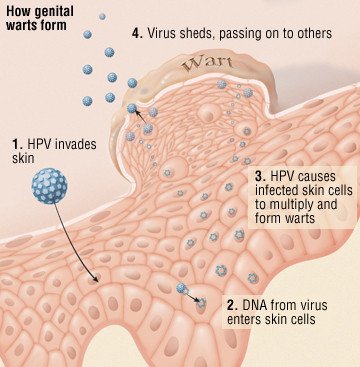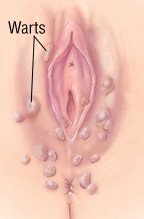Human Papilloma Virus (HPV)
Medically reviewed by Drugs.com. Last updated on Oct 11, 2023.
What is Human Papilloma Virus (HPV)?

Human papilloma virus (HPV) causes common warts, the small, white, beige or brown skin growths that can appear almost anywhere on the body and on the moist mucous membranes near the mouth, anus and genitals.
There are more than 150 different types of HPV, each with its own favorite skin surface to invade. Some cause the small, painless, rough-surfaced warts found on the fingers and face. Others cause the larger, more painful and flatter plantar warts that grow on the soles of the feet. More than 40 different types of HPV can infect the skin covering the sex organs, cervix and opening of the anus.
Genital HPV infections are very common. Up to 80 percent of sexually active adults will get an HPV infection of the genital area at some point in their lives. In most cases, these infections do not cause symptoms. They can cause genital warts
In a small number of women, certain HPV strains cause changes in the cervix that can become cancerous if not treated. HPV is also linked to cancers of the penis, vagina, anus, vulva, and also to mouth and throat cancers. HPV subtypes 16 and 18 are the causes of most cancers. HPV types 6 and 11 cause most cases of genital warts.
Human papilloma viruses usually are spread by direct skin contact, such as shaking the hand of someone who has a wart on their finger or having sexual intercourse with someone who has a genital HPV infection. Genital HPV infections can be spread by people with no symptoms, but the risk of infection is particularly high if you have intercourse with someone who has genital warts.
Less often, the viruses are carried on surfaces touched by someone who has warts, especially inside shoes that have been worn by someone with plantar warts. Once a person has been infected with an HPV, symptoms usually take three to four months to develop. However, in some cases, warts have developed as long as two years after contact with an infected person or contaminated surface.
|
|
Health experts estimate that common warts can be found on the hands of about one-fourth of all people in the United States, especially children. For some unknown reason, plantar warts are most common among teenagers and young adults.
Symptoms
It is possible to have an HPV skin or genital infection without having symptoms. When an HPV infection does cause a wart, the appearance varies slightly depending on its location:
- Common skin warts — These most often affect the hands, face, skin or scalp, and are especially common on sites of previous skin injury. They are small (about 6 millimeters or one-fourth of an inch), firm, painless, rounded growths that are whitish, pink, beige or brown. The wart surface may be smooth and pearly or rough like a cauliflower.
- Flat warts — These are flat, white, beige or brown growths. They do not usually itch. They typically occur on the face, neck, chest, forearms, wrists or hands.
- Plantar warts — These are thick, painful overgrowths of skin on the soles of the feet. They are often mistaken for simple calluses.
- Genital warts — These usually appear as one to 10 pink, painless growths with a rough, cauliflower-like surface. In men, genital warts most commonly affect the tip of the penis, the opening of the urethra and the skin around the anus (especially in men who practice anal sex). In women, genital warts usually appear first at the posterior opening of the vagina and on the labia (the lip-like folds of skin around the vagina).
|
|
Cancer caused by HPV often causes no symptoms. When symptoms do occur, it depends on the location of the cancer:
- Cervical cancer — Symptoms may include spotting after sex, abnormal vaginal bleeding, and/or pelvic pain.
- Oral cancer — Symptoms may include a tongue or mouth sore that doesn’t heal and/or a persistent discolored area in the mouth.
- Anal cancer — Symptoms may include bleeding, itching and/or pain around the anus.
Diagnosis
Your doctor usually can diagnose warts by examining the area. By looking at the area, your doctor also can determine what treatment may be necessary. In general warts don’t need to be biopsied. However, if your doctor is concerned that the changes could be cancerous, a skin biopsy may be needed. In a biopsy, a small piece of tissue is removed and examined under a microscope.
People with plantar warts may complain of pain on the bottom of their feet when walking. If you have possible plantar warts, your doctor will examine your affected foot. He or she will want to be sure there are no bone, joint or tendon problems that would explain the pain. Plantar warts might not be the actual cause of foot pain.
If you have possible genital warts, your doctor will ask about your sexual practices, including condom use and anal sex. Condoms help decrease the risk of getting infected with HPV and spreading it to partners. But the HPV might exist on areas not covered by a condom. If you engage in anal sex, your doctor will examine the area around and inside the anus for warts and other skin changes from HPV. If you engage in oral sex, your doctor can look for sores or discolored areas on your tongue and inside your mouth.
In women with genital warts, the doctor will do a pelvic and rectal exam. A Pap smear will be done to look for microscopic pre-cancer or early cancer of the cervix caused by HPV.
Your doctor may also do colposcopy to get a more detailed look at the surface of the cervix and vagina. This tube-like instrument has a light and lenses to give the doctor a magnified view of the cervix and nearby vaginal skin. A biopsy of abnormal cervical tissue may be necessary to look for cervical cancer.
DNA tests can identify the specific types of HPV infection in cells taken from a woman's cervix. The test helps to identify women who have the types of HPV infection associated with the development of cervical cancer.
Women ages 30 and over can opt for cervical cancer screening with HPV testing combined with a PAP smear once every 5 years (if prior PAP smears have been normal).
Expected Duration
Many warts disappear on their own. This may take one or two years. Others last for longer periods.
Prevention
There are two FDA approved vaccines against human papillomavirus, Gardasil and Cervarix. Both vaccines are approved for females to help prevent cervical cancer.
The general recommendation is to vaccinate 11 and 12 year old girls with either vaccine. Girls as young as 9 years old may receive the vaccine. A complete series consists of three shots over 6 months. The same vaccine brand should be used for all three shots. Both vaccines are also available for older girls and young women up to age 26.
Only Gardasil is approved to prevent genital warts. It is available to males as well as females. The age range to receive the Gardasil for boys and men is age 9 to 26.
Ideally, girls and young women should get all three HPV doses prior to becoming sexually active.
Other than abstinence, there is no definite way to prevent all HPV infections. To lower your risk as much as possible, always use condoms and other barrier methods, such as dental dams for mouth-to-genital contact, for protection. If you or someone you know has a wart, avoid skin-to-skin contact with the wart.
Treatment
Over-the-counter ointments, lotions and plasters are available to treat common skin warts. Do not use them for warts on the face, genitals or anus. They should not be used by people with diabetes, poor circulation or infected warts. Over-the-counter remedies use strong chemicals to slowly destroy the wart over a period of weeks or months. For faster and more lasting treatment, your doctor may try several procedures, including:
- Removing the wart surgically
- Freezing the wart (cryosurgery)
- Cauterizing the wart using electricity
- Applying stronger surface (topical) medications
A doctor should always examine warts on the face, genitals and anus. In some cases, the doctor will prescribe a medication such as podofilox (Condylox) or imiquimod (Aldara), which you can apply to the wart yourself. In other cases, you doctor will use an office-based treatment, such as:
- Surgical removal
- Cryotherapy (freezing)
- Application of strong medications, such as acids or podophyllum (Podofin, Podocon-25), to the skin
- Interferon injections
- Laser therapy
|
|
Several office visits may be necessary to complete your treatment.
Treatment options
The following list of medications are related to or used in the treatment of this condition.
When To Call A Professional
Make an appointment with your doctor whenever you suspect that you have a wart on your face, genitals or anus. If you have a wart on another area, you can try nonprescription treatments on your own, and see the doctor only if home treatment does not work.
If you are older than 45, talk to your doctor before trying to remove a common wart with an over-the-counter remedy. Your doctor may want to test for skin cancer.
Prognosis
The outlook varies. Many common warts disappear without treatment over 6 to 12 months. Others dissolve when an over-the-counter remedy is used for several weeks or months.
Of the office-based therapies, surgical removal of a wart gives the best immediate results, because the wart is cut away in one doctor's visit. Other forms of therapy require several office visits. After a wart has been removed, there is no guarantee that it will not come back, because it is difficult to be certain that HPV infection has been eliminated from the deeper layers of the infected skin. Some stubborn warts require several rounds of treatment before they go away for good.
Additional Info
Centers for Disease Control and Prevention
http://www.cdc.gov/
National Institute of Arthritis and Musculoskeletal and Skin Diseases
http://www.niams.nih.gov/
Learn more about Human Papilloma Virus
Treatment options
Further information
Always consult your healthcare provider to ensure the information displayed on this page applies to your personal circumstances.



